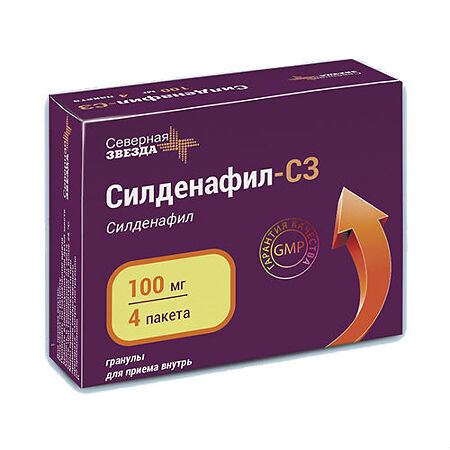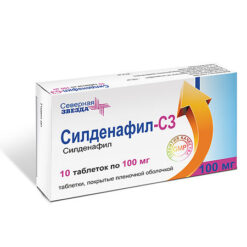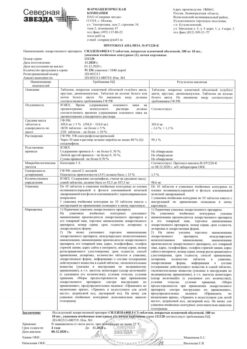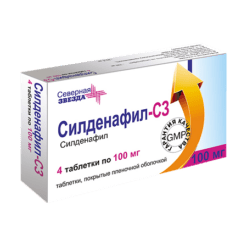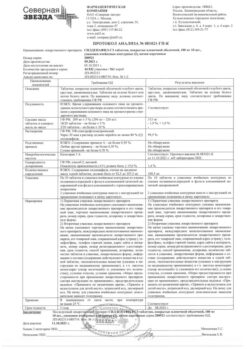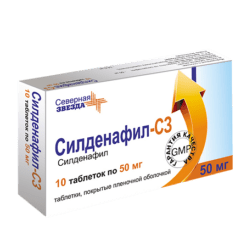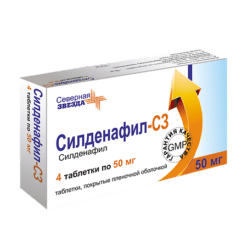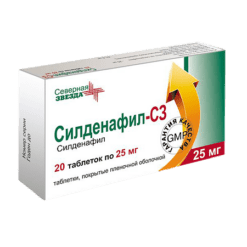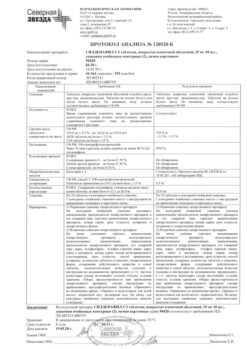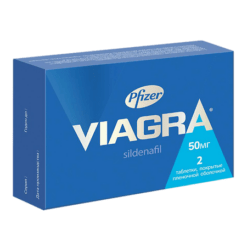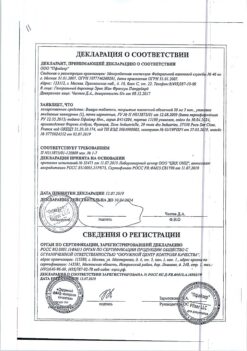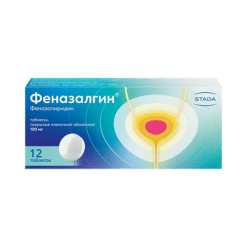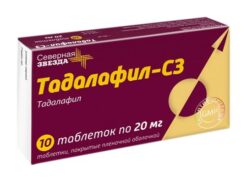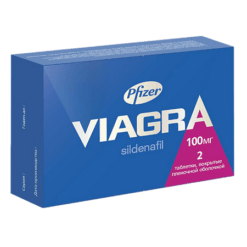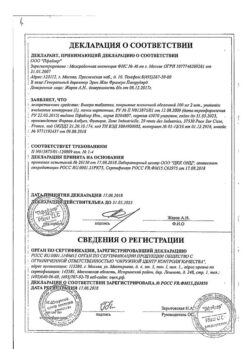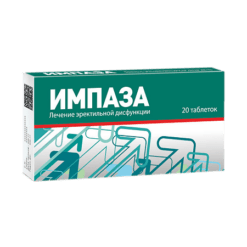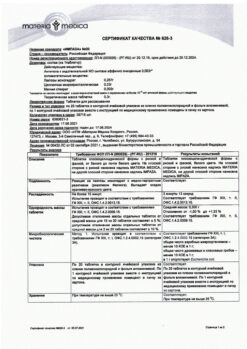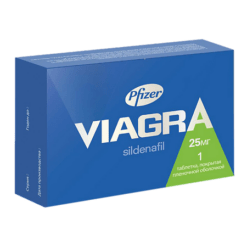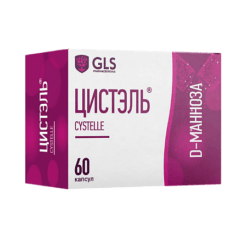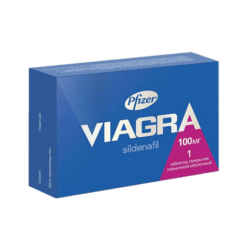No products in the cart.
Sildenafil-SZ, 100 mg 4 pcs
€6.18 €5.15
Out of stock
(E-mail when Stock is available)
Description
Treatment of erectile dysfunction – FDE-5 inhibitor.
Pharmacodynamics
Sildenafil is a potent selective inhibitor of cycloguanosine monophosphate (cGMP) – specific phosphodiesterase type 5 (FDE-5). Restores impaired erectile function under sexual stimulation by increasing blood flow in the vessels of the penis. Mechanism of action
The physiological process underlying penile erection involves the release of nitric oxide (N0) in the cavernous body against sexual stimulation. Nitric oxide activates the enzyme guanylate cyclase, which leads to an increase in the concentration of cGMP and the subsequent relaxation of the smooth muscle cells of the cavernous body and promotes its filling with blood.
It does not have a direct relaxing effect on the isolated human cavernous body, but it increases the effect of NO by inhibiting FDE-5, which is responsible for the cGMP breakdown. When NO/ cGMP system is activated against the background of sexual stimulation, inhibition of FDE-5 under the action of sildenafil leads to an increase of cGMP level in the cavernous body.
For development of desired pharmacological action of sildenafil sexual stimulation is necessary.
In vitro studies showed that sildenafil is selective with respect to FDE-5, involved in the process of erection. Its activity against FDE-5 is superior to activity against other known phosphodiesterases. Sildenafil is 10 times less selective against FDE-6, which is involved in phototransmission in the retina. At maximum recommended doses, sildenafil is 80 times less selective for FDE-1 and 700 times or more for FDE-2, 3, 4, 7, 8, 9, 10, and 11. Sildenafil activity against FDE-5 is approximately 4000 times higher than its activity against FDE-3 (cycloadenosine monophosphate (cAMP) – a specific phosphodiesterase), involved in regulation of myocardial contractility.
Sildenafil causes a slight and transient decrease of blood pressure (BP), which in most cases does not have clinical manifestations. The maximum decrease in systolic BP in the horizontal position after taking sildenafil at a dose of 100 mg averages 8.3 mmHg and diastolic BP 5.3 mmHg. This decrease in BP is due to the vasodilatory effect of sildenafil, possibly related to an increase in cGMP concentration in vascular smooth muscle cells. A single dose of sildenafil up to 100 mg is not accompanied by clinically significant changes in the electrocardiogram (ECG) in healthy volunteers. Sildenafil has no effect on cardiac output and does not change blood flow through stenotic arteries.
In patients with erectile dysfunction and stable angina pectoris who regularly took antianginal drugs (except nitrates), time to angina attack during exercise test was not significantly different after taking sildenafil compared to placebo.
In some patients 1 hour after taking 100 mg sildenafil using the Farnsworth-Munsel 100 test revealed transient changes in the ability to distinguish shades of color (blue/green), 2 hours after taking sildenafil these changes were absent. Inhibition of FDE-6 is considered to be the presumed mechanism of color perception impairment. Sildenafil has no effect on visual acuity or contrast perception, electroretinogram, intraocular pressure or pupil diameter. It was noted that in patients with early age-related macular degeneration sildenafil at a dose of 100 mg once did not cause clinically significant changes in vision as assessed by special tests (visual acuity, Amsler grid, traffic light color difference, Humphrey perimetry and photostress).
A single sildenafil dose of 100 mg had no effect on sperm motility or morphology in healthy volunteers. Additional information on clinical studies In studies examining fixed doses of sildenafil, the percentage of men who reported improved erections was 62% (25 mg), 74% (50 mg), and 82% (100 mg), compared with 25% in the placebo group. At the same time, the sildenafil withdrawal rate was low and comparable to that in the placebo group.
In all studies, the proportion of patients who reported improved erections after sildenafil use was as follows: psychogenic erectile dysfunction (84%), mixed erectile dysfunction (77%),
organic erectile dysfunction (68 %), elderly patients (67 %), diabetes mellitus (59 %), coronary heart disease (CHD) (69 %), arterial hypertension (68 %), prostate transurethral resection (61 %), radical prostatectomy (43 %), spinal cord injury (83 %), depression (75 %). Analysis of the international erectile dysfunction index
showed that in addition to improving erections, sildenafil treatment also improved the quality of orgasm, allowed to achieve satisfaction of sexual intercourse and overall satisfaction. The safety and efficacy of sildenafil persisted with long-term use.
Pharmacokinetics
Absorption
Sildenafil is rapidly absorbed. The maximum blood plasma concentration (Stah) when taken on an empty stomach is reached within 30-120 minutes (median is 60 minutes). Absolute bioavailability, on average, is about 41% (25-63%). Pharmacokinetics (area under the curve “concentration-time” (AUC) and Stah) of sildenafil in the range of recommended doses (25-100 mg) are linear. Food intake reduces sildenafil absorption rate, and time to reach the maximum concentration (TCtah) is prolonged on average by 60 min, AUC is reduced on average by 29 %.
Distribution
Distribution volume (Vd) of sildenafil in equilibrium is on average 105 l. After a single oral administration of 100 mg sildenafil, the Vd is approximately 440 ng/ml (coefficient of variation (CV) of 40%). Since sildenafil (and its major circulating N-demethylated metabolite) is 96% bound to plasma proteins, the average plasma concentration of the free sildenafil fraction is 18 ng/mL (38 nM).
In healthy volunteers, 90 minutes after a single administration of 100 mg sildenafil, less than 0.0002% of the dose (average, 188 ng) is detected in semen.
Metabolism
Sildenafil is metabolized mainly in the liver by microsomal cytochrome P450 isoenzymes: CYP3A4 (main pathway) and CYP2C9 (additional pathway). The main circulating active metabolite is formed as a result of N-demethylation of sildenafil. Metabolite selectivity to phosphodiesterases is comparable with that of sildenafil, and its activity against FDE-5 in vitro is approximately 50% of that of unchanged sildenafil. Concentration of the metabolite in blood plasma of healthy volunteers is about 40% of sildenafil concentration. N-demethylated metabolite is further metabolized, its half-life (Jm) is about 4 hours.
Excretion
Total clearance of sildenafil is 41 l/h, and the final half-life (T1/2) is 3-5 hours. Sildenafil is excreted as metabolites mainly by the intestine (about 80% of the dose) and to a lesser extent by the kidneys (about 13% of the dose).
Pharmacokinetics of selected groups of patients Elderly patients
In healthy elderly patients (65 years and older) sildenafil clearance is reduced, and concentration of sildenafil and its active N-demethylated metabolite in blood plasma is about 90% higher than in young patients (18-45 years). Taking into account age-related features of binding to plasma proteins, plasma concentration of free sildenafil increases by about 40%.
Renal dysfunction
In patients with mild to moderate renal dysfunction (creatinine clearance (CK) 30-80 ml/min) pharmacokinetics of sildenafil after a single dose of 50 mg did not change. Mean AUC and Stach values of N-demethylated metabolite increased by 126% and 73%, respectively, compared to healthy patients of the same age. Due to high interindividual variability, these differences are statistically insignificant. In severe renal insufficiency (CKR less than 30 ml/min) sildenafil clearance decreases, which leads to approximately twofold increase of AUC (100%) and Stakh (88%) in comparison with similar indices in patients of the same age group without renal dysfunction.
Hepatic dysfunction
In patients with Child-Pugh class A and B liver cirrhosis, sildenafil clearance is decreased, resulting in increased AUC (84 %) and Stach (47 %) compared to patients with normal liver function in the same age group. The pharmacokinetics of sildenafil in patients with severe hepatic impairment have not been studied.
Indications
Indications
Active ingredient
Active ingredient
Composition
Composition
How to take, the dosage
How to take, the dosage
Interaction
Interaction
Special Instructions
Special Instructions
Synopsis
Synopsis
Contraindications
Contraindications
Side effects
Side effects
Overdose
Overdose
Pregnancy use
Pregnancy use
Similarities
Similarities
Additional information
| Shelf life | 3 years. Do not use after the expiration date stated on the package. |
|---|---|
| Conditions of storage | In the dark place at a temperature not exceeding 25 ° C. |
| Manufacturer | North Star NAO, Russia |
| Medication form | granules for oral administration |
| Brand | North Star NAO |
Other forms…
Related products
Buy Sildenafil-SZ, 100 mg 4 pcs with delivery to USA, UK, Europe and over 120 other countries.

